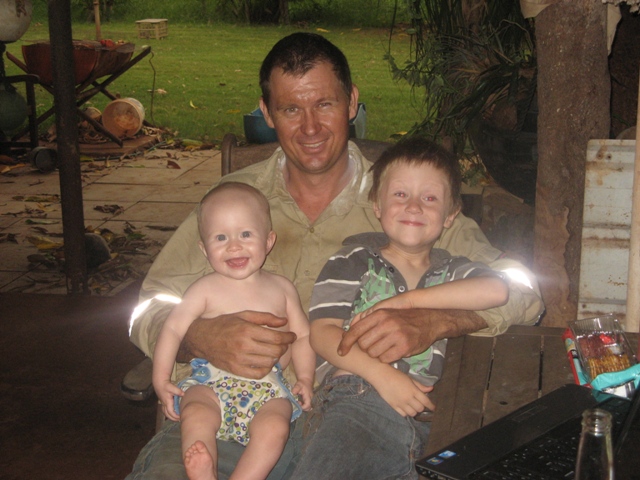What Do You Do When There’s No Cattle Market?
Host: Country Downs Station
Written by Nikki Elezovich – Owner, Country Downs Station.
So, it’s our final instalment for our week as hosts of Central Station and seeing as you have all met the “Big Boss” and “The Backpacker”, it wouldn’t too hard to figure out who I have referred to as “The Bean counter”. That would be me, of course! And aren’t you all lucky . . . you got to spend five days in my head! So seeing as it’s a Sunday and that’s a hell of an excuse to wile away my day of rest (??!!) espousing more anecdotal garbage at you all, I will continue to tell you our story. As with most ‘couples’ (not all, I know . . . Mrs Plains! ) that run their own business, I take care of most of the admin stuff including the books and the budgets and making sure that they at least look the part so that “Mr Banker” is more amenable to our advances during the hard times!
And what hard times we have been having since the Live Export Suspension in 2011. Now I know that pretty much all of you reading will have an inordinate amount of knowledge about what happened and the indirect repercussions to the northern beef industry since then, so I won’t bore you all with the details. However, it was a huge transition for us as a small, developing family business to suddenly have to find some other way of paying the bills. I will admit that due to our own little niche within the livestock market (we had great access to the middle-eastern markets as well as Indonesia), we were probably not as hard hit, initially, as the majority of pastoral operations in the Kimberley. Since 2011, however, and the ongoing debacle with our political relationship with Indonesia, what has happened to us is that the other producers in our area are now doing everything they can to access the same markets that we have always had . . . and rightly so as their traditional market (Indonesia) is no longer reliable. As we are such a small operation (in terms of turnover numbers as we are still developing), however, in comparison to these other, much larger enterprises, we are finding that we are starting to ‘miss out’ on many of the opportunities that in the past, have saved us.
This year, 2013, it has come to a head for us. As of today, we have only managed to sell 121 head of cattle! This is nowhere near enough to cover our annual expenditure. So it begs the question . . . What do you do when there is no cattle market anymore? Well, what we are doing is diversifying!
To pay the bills this year, we (well I should say Kurt, I had the job of making sure the station kept ticking over!) had to go out and do earth moving contracting with our machinery, which we have been supremely lucky to even have the opportunity of doing as close to our property as it is (meaning it didn’t cost us much as it would have if it were a further distance from our base). That’s a short-term form of diversification that we are undertaking as . . . for obvious reasons . . . we would much prefer to spend our time with cattle. We could never have done the contract jobs without the help from our family. Kurt’s folks and a very close family friend came up and spent months up here this year. Kurt’s dad, Jack, was Kurt’s offsider driving a backup vehicle on the big contract job and Norman spent most of his time fixing our breaking-down machinery! We are indebted to them for giving their time and effort to help us out.
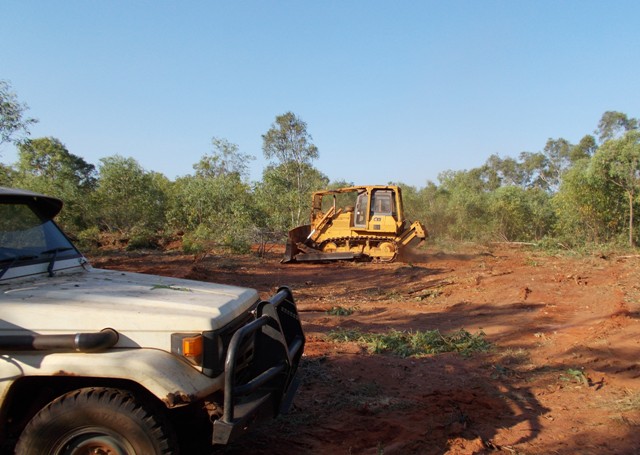 Kurt clearing a drill pad in the new (second-hand!) dozer to do the contract work this year.
Kurt clearing a drill pad in the new (second-hand!) dozer to do the contract work this year.
Another diversification project that we are undertaking for long-term benefit is cropping, or more accurately in our situation, fodder production. A couple of years ago we received a permit to clear approximately 230 hectares to plant improved pasture in order to produce supplementary feed for our sale cattle. We can utilise this fodder in two main ways. We can either cut it and bale it as hay to feed our sale cattle or weaners (or any cattle really) in the yards. Or we can put the cattle that we want to be fattened up on the 230ha to graze the pasture down.
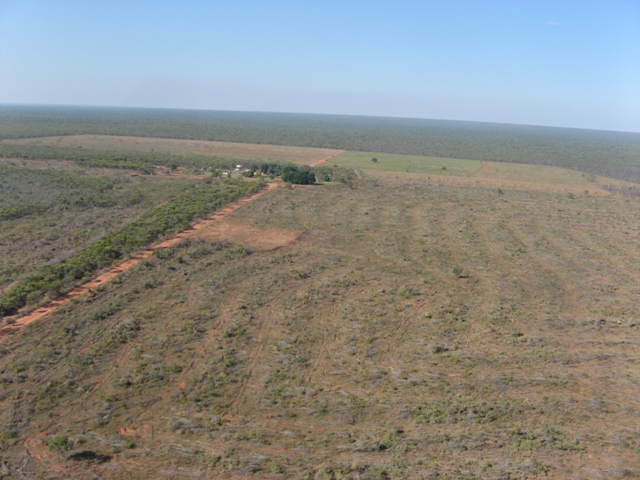 Our diversification permit area. 230ha surrounding the homestead area (the ‘green’ centre).
Our diversification permit area. 230ha surrounding the homestead area (the ‘green’ centre).
 The good old ‘Chamberlain’ with a somewhat home-altered seed drill, Jan 2012.
The good old ‘Chamberlain’ with a somewhat home-altered seed drill, Jan 2012.
Our project is relatively innovative in terms of the Kimberley region, mainly because we are not irrigating our pasture. We are doing what is termed ‘Dry-land Crop production’. This means that we are relying on our annual rainfall to grow the improved pasture for fodder. With a 980mm annual rainfall average, one would think this wouldn’t be too hard! Well, one (or two!) were wrong. Once again, I was reminded that when you trying to control anything that is dependent on nature to thrive, anything can and usually does go wrong! Despite a couple of setbacks from abnormal seasonal events, we actually undertook a project with Rangelands Natural Resource Management (NRM) to trial the success (or failure!) of a number of different varieties of improved pasture grown under dry-land conditions. To us, even the failures were a success as without the support and contributions from Rangelands, we would have had to spend years (and lots more dollars) figuring this out on our own. Now we have some great preliminary results that can be shared with the entire pastoral community so that they can also consider their opportunities with diversification in their enterprises. We are hoping that it can lead to a situation in the Kimberley region where everyone can move ahead again . . . well as long as the government doesn’t keep holding us back . . . but don’t get me (or Kurt . . . or anyone in our industry!) started on that subject.
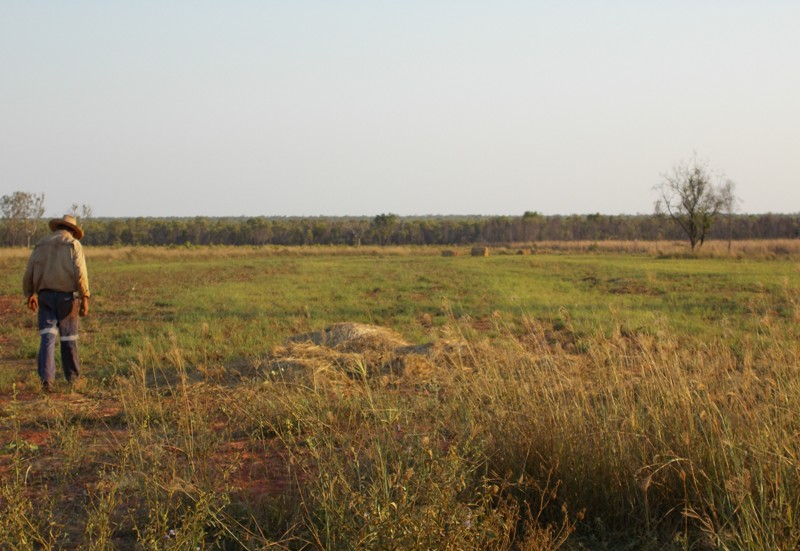 Our first bales of hay (in the distance) from the trial with Rangelands, we managed to cut and bale appoximately 5% of our crop this year (approximately 5ha) before ‘other priorities’ appeared. This area is already re-growing and producing new seed heads, so we are calling it a ‘success’!
Our first bales of hay (in the distance) from the trial with Rangelands, we managed to cut and bale appoximately 5% of our crop this year (approximately 5ha) before ‘other priorities’ appeared. This area is already re-growing and producing new seed heads, so we are calling it a ‘success’!
Whilst not technically considered to be diversification, the other method we are utilising in order to give ourselves a long-term benefit is by increasing the genetic diversity of our livestock. As I mentioned briefly on my first blog, we have started developing a composite herd structure in the anticipation that one day in the (and hopefully not too far . . . ) future, instead of having a good-looking, perfect line of classic Brahman stock that limits our market access, we in fact have a more physically disparate line of animals that have the potential to fit into any (or even more miraculously . . . all!) markets. Well, that’s the aim anyway! Kurt has spent numerous hours on the internet and talking to stud producers researching what I call his version of ‘porn’ . . . different breeds of cattle! But all of this has led to us making the decision to increase the genetic variability of our herd by buying in bulls of different breeds that we can put over our high quality Brahman and Brahman cross breeder cows. So hopefully in the next few years we will be able to reap the benefits of a successful (albeit intrepid), business plan! Optimism . . . it’s not for the faint-hearted, but it obviously works!
The other form of diversification that we, and Kurt in particular, believes whole-heartedly in is that of adapting. We must, individually, be able to adapt to ever-changing and new situations, whether they be of environmental, economic, and more so nowadays, social origins. A recent workshop in Mataranka that Kurt attended had Allan Savory as the guest speaker, renowned world-wide for his expertise and knowledge in the subject of Holistic Management. The one thing that was pivotal to our understanding of it was that nothing ever stays the same. The relationship between all organisms in nature (and as a biologist, this is the crux of it) is complex (not to be confused with complicated!) and in a continual state of flux. The whole concept of Holistic Management is to know and accept this and therefore be adaptable to these changes that will always happen. Kurt’s two favourite quotes of Allan Savory’s were:
- ‘Plan, Monitor, Replan’, which basically means decide on a management practice, enact it, but constantly review it to make sure it is still working and if it isn’t, develop another management practice to achieve your end goal.
- ‘Don’t face problems, face solutions” . . . deep, but apt when you consider the mental attitude behind it!
Both these quotes sound simple really . . . until you have to put them into practice! But as they say . . . it was never meant to be easy!
Well, that about sums up life and goals at Country Downs . . . well the “broad-acre” version anyway. Unfortunately, our week of hosting Central Station is at an end, despite there are still being so many stories that we could yarn to you all about, like how a good portion of our machinery, equipment, and building supplies (and even pots in my kitchen), have found their way onto our property via a number or ‘waste-recycling facilities’ and cyclone clean-up collections, local skip bins and general unwanted ‘stuff’ that got thrown at us because no-one else wanted it. We have three tractors, a grader, two Utes, solar panel battery units, and a multitudinous number of gensets (generators), just to name a few, that we have salvaged or paid for in cartons of beer/rum or killers.
And about when Kurt and I, just the two of us, spent six days fencing a new paddock, an approximate total of 60km in the heat of early December, 2008 . . . all when I was seven months pregnant! Towards the end of this little adventure the rain belted down on the road between us and homestead and we got bogged going home . . . so we had to walk! There was no-one at the homestead to come looking for us and we hadn’t yet got the satellite phone! I managed to walk 10km before I felt like I was about to have the baby and Kurt had to walk another 8km to pick up a truck (that thankfully we had left in the middle of nowhere one day previously!) and come and pick me up, by which time was about 8pm. We finally got home at about 10.30pm to find one of our dogs had chewed the end out of our beautiful woven antique bassinet and a number of phone calls on the answering machine . . . wishing Kurt a ‘Happy Birthday’! Aaahhhh, why would you ever want to trade such bliss?
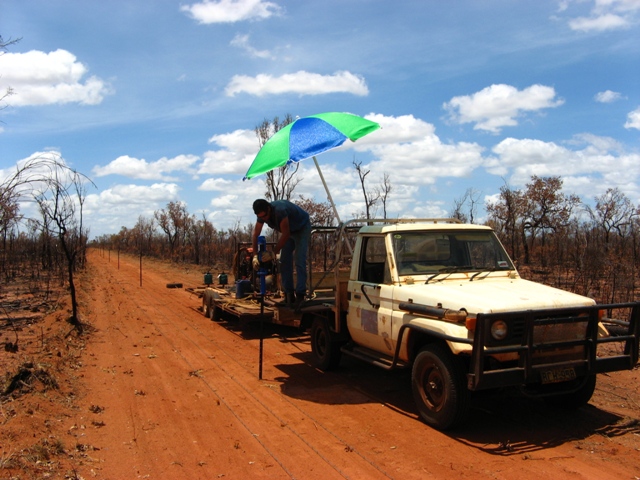 Fencing in early Dec 2008. The umbrella made it look like a beach holiday . . . NOT!
Fencing in early Dec 2008. The umbrella made it look like a beach holiday . . . NOT!
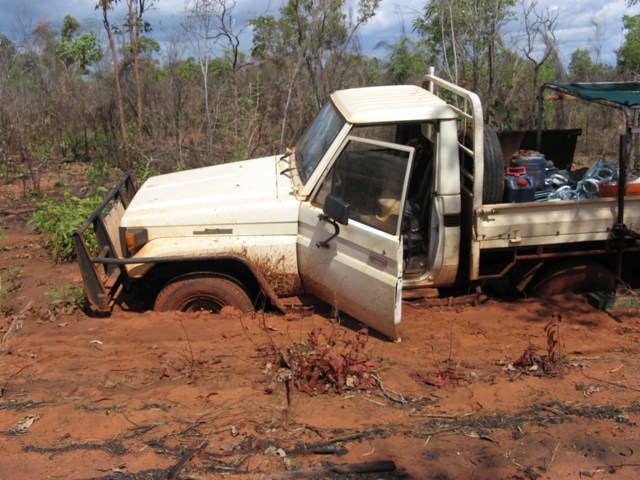 The result of too much rain in a short amount of time . . . I said to Kurt after we had walked about 5km, “We wouldn’t have had to walk as far if I had been driving!” This is only because I would have bogged sooner and therefore been closer to the truck!
The result of too much rain in a short amount of time . . . I said to Kurt after we had walked about 5km, “We wouldn’t have had to walk as far if I had been driving!” This is only because I would have bogged sooner and therefore been closer to the truck!
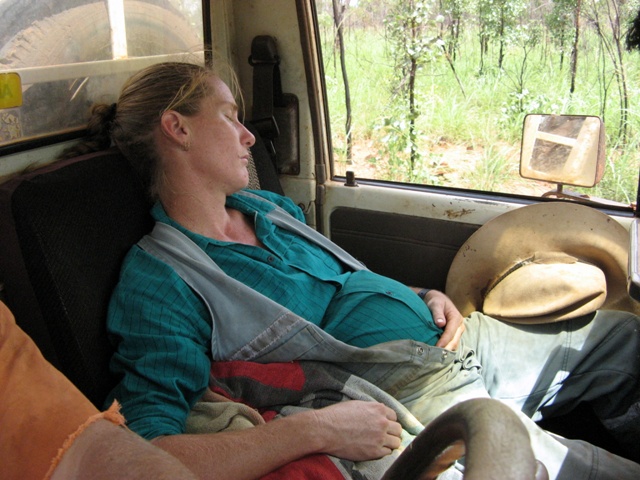 Fencing and installing pumps/pipe etc into two new bores takes it out of a seven month pregnant woman! Nov/Dec 2008.
Fencing and installing pumps/pipe etc into two new bores takes it out of a seven month pregnant woman! Nov/Dec 2008.
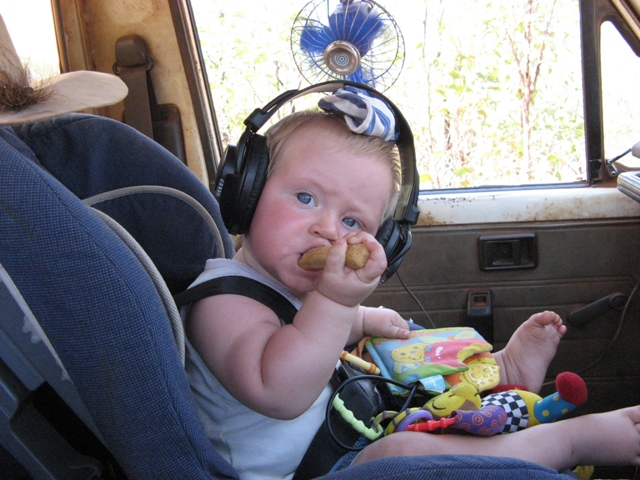 “Working Boy”, Oct 2009. William was about seven months old when we had to do some more fencing. The headphones were not for music, but to protect his ears from the pneumatic post driver we use to drive pickets (work smarter not harder!) . . . maybe that’s why he doesn’t seem to notice when I am telling him what to do now
“Working Boy”, Oct 2009. William was about seven months old when we had to do some more fencing. The headphones were not for music, but to protect his ears from the pneumatic post driver we use to drive pickets (work smarter not harder!) . . . maybe that’s why he doesn’t seem to notice when I am telling him what to do now
The last week has not only been a lot of fun, laughter, a bit of angst, and a large amount terror (for me anyway!), but it has been incredibly cathartic for me on a personal level. I have had to sit down and make the time to write these glimpses into our life. Now for a non-spontaneous, anally retentive ISTJ (those who have done Myers-Briggs will understand!), like myself, that is terrifying. But what I have gained in doing these chronicles has surprised me. As I am the ‘details’ kind of person, I frequently get lost in the small things, which inevitably stresses me out, but this week has served to remind me of the big picture of what it is we are doing (. . . the long-term picture that is). As we all know, it is good to just sometimes, take a step back and look at the forest, not the trees. In addition, I have learnt that it isn’t the end of the world if people who you don’t know, know intimate details about your life, that’s what sharing is about.
So we will say adieu and thank you for your attention, support, and lovely comments and more importantly thank you for allowing us the time and space to share our love of this lifestyle and to re-learn what it is that is important to us and our dreams. This has been a learning curve (and a refresher course), for us too and we are grateful to the wider community for making us feel the need to do this and therefore finding out a little more about ourselves in the process. We can only hope that everyone who has followed us this week (and all the other blogs) enjoys the experience as much as we have. Thanks to all who have made it possible, namely the spirited women who went to Indonesia and formed the whole idea, and to Steph Coombes who with such patience and politeness, despite her own busy agenda, has made the whole presentation of everyone’s stories fit seamlessly.
Until next time, ciao ciao from us mob at Country Downs.
(Oh and by the way, if any readers are feeling like living the rustic lifestyle that we on Country Downs are accustomed to . . . for gratitude and thanks only (oh . . . and meat of course) . . . then look us up if you are over this way! We have lots of room on our back lawn and the goats and pig would probably appreciate some extra warmth at night! Ha ha!)

